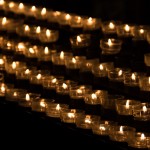As early as the mid-1800s, novelists, artists, philosophers, essayists and prophets questioned the great promise of modernity. Does progress always mean improvement? Can production and technology cause poverty? Is science always good? Is the rat race inherently unhealthy? Is there any meaning to life? Is truth anything more than a temporary construct?
Fr. John O’Donohue (1956-2008) succinctly summarizes the downside of modern life:
“The traditional shelters no longer offer any shelter. Religion often seems discredited… Politics seems devoid of vision and is becoming more and more synonymous with politics. Consumerist culture worships accumulation and power… In admiring the achievement and velocity of these tiger economies, we refuse to notice the paw marks of its ravages and the unglamorous remains of its prey.”
O’Donohue, in Eternal Echoes (Bantam Books, 1998), then names a crucial but oft unacknowledged symptom:
“All these factors contribute to the dissolution of real presence. The homeless mind is haunted by a sense of absence that it can neither understand nor transfigure. Indeed, in its desperation it endeavors to fill every moment with some kind of forced presence.”
Oliver Sacks (1933-2015) became popular with a book that had an unusual title: The Man Who Mistook His Wife for a Hat (Touchstone, 1985). One of his patients it seems suffered from visual agnosia, a neurological affliction resulting in an inability to recognize familiar objects.
For Sacks, this patient’s predicament is a metaphor for a societal disease: We have lost the ability to truly recognize one another. Instead we often relate to others as a utilitarian means to another purpose. Our politics (liberal and conservative) and our ethics (in business and even in private) are based on calculating the worth of people. Our bottom line culture is the opposite of what Pope Francis calls “a culture of encounter.”
Small gestures can begin to restore a culture of meaningful relationships. The personal necessarily has to be brief in the grocery checkout and at the oil change shop, but it can be a portion of the exchange. The personal can be deeper and more extensive in the workplace, though there are limits. The prime arenas for dispelling social agnosia are one’s church or mosque, union local, civic group and the like. These are public institutions that by design must turn outward toward a mission. But these community places must also foster personal exchange. To the extent they balance a necessary outward thrust with one-to-one exchange, these local groups make our culture whole in ways that business, government and technology cannot.
Among these local groups, some Christian churches apply term real presence (the term O’Donohue uses) to the dogma of the Eucharist. Jesus is really present in the action of each Mass, these Eucharist churches believe. Further, Jesus is really present in the world, according to the once popular doctrine of the Mystical Body of Christ. Thereby, each and every encounter is a meeting with Christ and should be conducted in a way that each person is treated as an end in themselves. Eucharist churches that form their members around instruction and devotion to the real presence contribute to a genuine society. As such churches promote real presence in their worship, so too must they reinforce the notion of real presence in the world through deliberate attention to one-to-one relationships.
Droel’s book Monday Eucharist is at National Center for the Laity (PO Box 291102, Chicago, IL 60629; $8).










